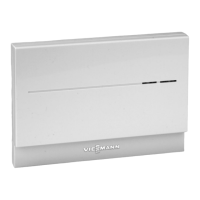
Do you have a question about the Viessmann VITOTROL 200 RF and is the answer not in the manual?
| Display | LCD |
|---|---|
| Type | Remote Control |
| Compatibility | Viessmann heating systems |
| Range | Up to 30 meters |
| Functions | Temperature control, timer, programming |
| Power Supply | 2 x AA batteries |
| Temperature Range | 5°C to 30°C |
Essential guidelines to follow for safe operation and to prevent accidents and material losses.
Clarifies the meaning of warning symbols like 'Danger' and 'Please Note' for user safety.
Defines intended users and emphasizes supervision for children's safety around the unit.
Critical steps to take if a gas leak is detected to prevent explosions and injury.
Procedures for handling potential poisoning from flue gas and risks associated with fire.
Specifies temperature limits and air quality requirements for safe boiler room operation.
Warns against using untested parts and mandates qualified personnel for installation/replacement.
Details the wireless connection and initial setup performed by a heating contractor.
Directs users to an appendix for definitions of terms used in the manual.
Provides practical tips for reducing energy consumption and heating costs.
Outlines the adjustments users can make to their heating system from the living space.
Explains the purpose of each button on the Vitotrol 200 RF remote control.
Interprets the various icons and indicators shown on the remote control's display screen.
Verifies room temperature and heating program settings for central heating operation.
Step-by-step guide to adjust the room temperature using the control buttons.
Instructions for selecting appropriate heating modes like winter, summer, or standby.
Enables temporary temperature adjustments for increased comfort, e.g., when guests are present.
Guides users on activating economy mode to reduce temperature and save energy.
Solutions for rooms that are too cold, including checking settings and fuel supply.
Remedies for rooms that are too hot, focusing on settings and potential fault messages.
Troubleshooting steps for issues with hot water availability, checking settings and system faults.
Explains how to acknowledge and address specific fault codes displayed by the system.
Advice for resolving problems related to the wireless connection between units.
Instructions for changing batteries when low and proper disposal methods.
Provides definitions for technical terms to enhance user understanding of the system.